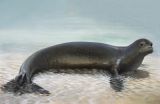(Press-News.org) The recently extinct Caribbean monk seal (Monachus tropicalis) was one of three species of monk seal in the world. Its relationship to the Mediterranean and Hawaiian monk seals, both living but endangered, has never been fully understood. Through DNA analysis and skull comparisons, however, Smithsonian scientists and colleagues have now clarified the Caribbean species' place on the seal family tree and created a completely new genus. The team's findings are published in the scientific journal ZooKeys.
First reported by Columbus in 1494, the Caribbean monk seal ranged throughout the Caribbean with an estimated population in the hundreds of thousands. Unrestricted hunting in the 19th century, however, caused a rapid decline in numbers. The last definite sighting of a Caribbean monk seal was in 1952, making it the most recent extinction of a marine mammal in the Western Hemisphere.
To find the answers about the classification of the Caribbean monk seal, the scientists turned to DNA extracted from century-old monk seal skins in the Smithsonian's collections. For the DNA comparisons, the Smithsonian team worked with scientists at the Leibniz Institute of Zoo and Wildlife Research in Germany and Fordham University in New York. Their analyses showed that the Caribbean species was more closely related to the Hawaiian rather than the Mediterranean monk seal. It also showed that Caribbean and Hawaiian monk seals split into distinct species around 3 to 4 million years ago―the same time the Panamanian Isthmus closed off the connection between the Atlantic and Pacific Oceans, which would have naturally separated the two.
"Scientists have long understood that monk seals are very special animals," said Kristofer Helgen, curator of mammals at Smithsonian's National Museum of Natural History. "This study is exciting because it gives us a clearer view of their evolution and provides us with new context that highlights the importance of conserving these remarkable and endangered seals."
The team's analysis determined that the molecular and morphological differences between the Mediterranean species and the two New World species (Caribbean and Hawaiian) were profound. This led them to classify the Caribbean and Hawaiian monk seals in a newly named genus, Neomonachus. This remarkable discovery is the first time in more than 140 years that a new genus has been recognized amongst modern pinnipeds (seals, sea lions, and walruses).
"We occasionally identify new species of larger mammals, like the olinguito we announced last year," said Graham Slater, co-author and Peter Buck Post Doctoral Fellow at the Smithsonian. "But to be able to name a new genus, and a seal genus at that, is incredibly rare and a great honor."
Monk seals, as a group, are unusual among seals in being adapted for life in warm water. With the Caribbean species now extinct, the Hawaiian monk seal is the last surviving species of the genus Neomonachus, as the Mediterranean species is in its genus, Monachus. Both species are listed as "critically endangered" by the International Union for Conservation of Nature. With about 1,200 Hawaiian but less than 600 Mediterranean monk seals left, they are some of the rarest mammals on Earth.
INFORMATION:
Original Source:
Scheel DM, Slater GJ, Kolokotronis S-O, Potter CW, Rotstein DS, Tsangaras K, Greenwood AD, Helgen KM (2014) Biogeography and taxonomy of extinct and endangered monk seals illuminated by ancient DNA and skull morphology. ZooKeys 409: 1-33. doi: 10.3897/zookeys.409.6244
Extinct relative helps to reclassify the world's remaining 2 species of monk seal
2014-05-14
ELSE PRESS RELEASES FROM THIS DATE:
Research reveals New Zealand sea lion is a relative newcomer
2014-05-14
The modern New Zealand sea lion is a relative newcomer to our mainland, replacing a now-extinct, unique prehistoric New Zealand sea-lion that once lived here, according to a new study.
A team of biologists from New Zealand's University of Otago estimates that this prehistoric mainland sea-lion population became extinct as recently as 600 years ago, and was then replaced by a lineage previously limited to the waters of the cold subantarctic.
The Marsden-funded study, carried out by Otago Zoology PhD student Catherine Collins, and led by Professor Jon Waters, set out ...
New technology simplifies production of biotech medicines
2014-05-14
The final step in the production of a biotech medicine is finishing with the correct sugar structure. This step is essential for the efficacy of the medicine, but it also makes the production process very complex and expensive. Leander Meuris, Francis Santens and Nico Callewaert (VIB/UGent) have developed a technology that shortens the sugar structures whilst retaining the therapeutic efficiency. This technology has the potential to make the production of biotech medicines significantly simpler and cheaper.
Sugar structures are essential for the mechanism of biotech ...
@millennials wary of @twitter, #MSU study finds
2014-05-14
EAST LANSING, Mich. --- A new study indicates young adults have a healthy mistrust of the information they read on Twitter.
Nearly anyone can start a Twitter account and post 140 characters of information at a time, bogus or not, a fact the study's participants seemed to grasp, said Kimberly Fenn, assistant professor of psychology at Michigan State University.
"Our findings suggest young people are somewhat wary of information that comes from Twitter," said Fenn, lead investigator on the study. "It's a good sign."
The study, funded by the National Science Foundation, ...
Prevent premature deaths from heart failure, urges the Heart Failure Association
2014-05-14
Athens, 14 May 2014. The Heart Failure Association (HFA) of the European Society of Cardiology (ESC) is calling for global policy change relating to heart failure. An international white paper, Heart failure: preventing disease and death worldwide, will be presented at an endorsement event on 16 May 2014 in Athens, Greece, immediately before the Heart Failure 2014 Congress.
Approximately 15 million people are living with heart failure in Europe,1 and 26 million worldwide.2 The outlook is poor: survival rates are worse than those for bowel, breast or prostate cancer, and ...
Understanding the 1918 flu pandemic can aid in better infectious disease response
2014-05-14
COLUMBIA, Mo. – The 1918 Flu Pandemic infected over 500 million people, killing at least 50 million. Now, a researcher at the University of Missouri has analyzed the pandemic in two remote regions of North America, finding that despite their geographical divide, both regions had environmental, nutritional and economic factors that influenced morbidity during the pandemic. Findings from the research could help improve current health policies.
"Epidemics such as the Black Death in the 14th century, cholera in the 19th century and malaria have been documented and recorded ...
Tiny, tenacious and tentatively toxic
2014-05-14
COLLEGE STATION – Sometimes we think we know everything about something only to find out we really don't, said a Texas A&M University scientist.
Dr. Kevin Conway, assistant professor and curator of fishes with Texas A&M's department of wildlife and fisheries sciences at College Station, has published a paper documenting a new species of clingfish and a startling new discovery in a second well-documented clingfish.
Smithsonian Institution
The paper, entitled "Cryptic Diversity and Venom Glands in Western Atlantic Clingfishes of the Genus Acyrtus (Teleostei: Gobiesocidae)," ...
Chapman University affiliated physicist publishes on the Aharonov-Bohm effect in Nature
2014-05-14
ORANGE, Calif. – Chapman University affiliated quantum physicist Yutaka Shikano, Ph.D., has published a milestone paper in the prestigious journal Nature Communications. The title of the article is "Aharonov-Bohm effect with quantum tunneling in linear Paul trap." The Aharonov-Bohm (AB) effect was proposed by Yakir Aharonov, who is the co-director of the Institute for Quantum Studies at Chapman University, and David J. Bohm in 1959.
The AB effect showed for the first time that a magnetic field inside a confined region can have a measureable impact on a charged particle ...
Simplifying an ultrafast laser offers better control
2014-05-14
This news release is available in French. Going back to the drawing board to find a way to overcome the technical limitations of their laser, a team led by François Légaré, professor at the INRS Énergie Matériaux Télécommunications Research Centre, developed a new concept offering a simpler laser design, control over new parameters, and excellent performance potential. Called "frequency domain optical parametric amplification" (FOPA), the concept supersedes traditional time domain amplification schemes that have been the linchpin of ultrafast laser science for 20 years. ...
Magnetar formation mystery solved?
2014-05-14
When a massive star collapses under its own gravity during a supernova explosion it forms either a neutron star or black hole. Magnetars are an unusual and very exotic form of neutron star. Like all of these strange objects they are tiny and extraordinarily dense — a teaspoon of neutron star material would have a mass of about a billion tonnes — but they also have extremely powerful magnetic fields. Magnetar surfaces release vast quantities of gamma rays when they undergo a sudden adjustment known as a starquake as a result of the huge stresses in their crusts.
The Westerlund ...
Microchip-like technology allows single-cell analysis
2014-05-14
VIDEO:
This is a microscopic view of the new microchip-like technology sorting and storing magnetic particles in a three-by-three array.
Click here for more information.
DURHAM, N.C. -- A U.S. and Korean research team has developed a chip-like device that could be scaled up to sort and store hundreds of thousands of individual living cells in a matter of minutes. The system is similar to a random access memory chip, but it moves cells rather than electrons.
Researchers at ...





